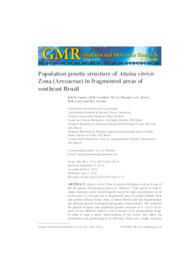Population genetic structure of Attalea vitrivir Zona (Arecaceae) in fragmented areas of southeast Brazil.
Population genetic structure of Attalea vitrivir Zona (Arecaceae) in fragmented areas of southeast Brazil.
Autoria: SANTOS, R. R. M.; CAVALLARI, M. M.; PIMENTA, M. A. S.; ABREU, A. G. de; COSTA, M. R.; GUEDES, M. L.
Resumo: Attalea vitrivir Zona (synonym Orbignya oleifera) is one of the six species of Arecaceae known as ?babassu?. This species is used to make cosmetics, food, and detergents due to the high concentration of oil in the seeds. It is found only in fragmented areas of southern Bahia State and northern Minas Gerais State, southeast Brazil, and this fragmentation has affected both its ecological and genetic characteristics. We evaluated the genetic diversity and population genetic structure of A. vitrivir in six areas of two different regions at the extremes of its geographical range, in order to gain a better understanding of the factors that affect the distribution and partitioning of its diversity. Nine inter simple sequence repeat (ISSR) markers amplified 74 polymorphic bands, resulting in large diversity values (Shannon diversity index, 0.37-0.47; intrapopulation genetic diversity, 0.25-0.34). Analysis of molecular variance (AMOVA) revealed considerable differentiation between sampling sites (30.03%) and regions (12.08%), although most of the diversity was observed within sampling sites (69%). Further differentiation between sampling sites was noted more in the northern region than in the southern region, highlighting the genetic connectivity between the sampling sites within Rio Pandeiros Environmental Protection Area (southern region). The identification of two distinct genetic clusters (K = 2) corresponded to the northern and southern regions, and corroborated the AMOVA results. We suggest that the northern area, outside Rio Pandeiros Environmental Protection Area, must be included in future management plans for this species.
Ano de publicação: 2015
Tipo de publicação: Artigo de periódico
Unidade: Embrapa Cocais
Observações
1 - Por padrão são exibidas publicações dos últimos 20 anos. Para encontrar publicações mais antigas, configure o filtro ano de publicação, colocando o ano a partir do qual você deseja encontrar publicações. O filtro está na coluna da esquerda na busca acima.
2 - Para ler algumas publicações da Embrapa (apenas as que estão em formato ePub), é necessário ter, no celular ou computador, um desses softwares gratuitos. Sistemas Android: Google Play Livros; IOS: iBooks; Windows e Linux: software Calibre.
Acesse outras publicações
Acesse a Base de Dados da Pesquisa Agropecuária (BDPA) para consultar o acervo completo das bibliotecas da Embrapa.

